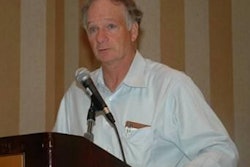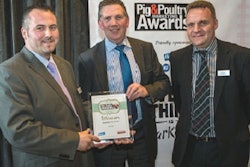Keeping solids out of the wastewater stream is job number one at Marshall Durbin’s chicken processing operation in Jasper, Ala. A focus on pollution prevention helped the plant win the U.S. Poultry & Egg Association 2013 Clean Water Award in the pretreatment category.
An adage used by wastewater environmental specialists defines pollution prevention—“If you don’t make it dirty in the first place, you don’t have to pay to clean it up.” That adage can be heard daily at Marshall Durbin’s chicken processing operation, where keeping solids out of the wastewater stream is a plant-wide team effort.
The Jasper plant processes 1.2 million broilers per week, generating approximately 1 million gallons of high-strength process wastewater daily that is pretreated on-site prior to discharge into the City of Jasper’s municipal sewer system.
Taking ownership of pollution prevention
Pollution prevention is a plant-wide focus, according to Ronnie Eddy, the company’s director of processing, and is everybody’s job.
“We take ownership of everything in the processing operation. Like most poultry plants, we are ever changing here; we’re evolving all the time. To be successful, nothing in the plant can be somebody else’s job. If you see a way to keep something out of the drain to help the wastewater operation, then you take care of it,” Eddy said.
The focus on pollution prevention begins in the processing operations and includes a vacuuming system, which captures byproducts from 13 points on the processing floor to be pumped directly to the offal transport trailers.
With support at the corporate level from Eddy and James Faison, vice president of science and quality assurance, and from plant manager Mark Dean, the environmental staff in Jasper reaps the benefits of daily pollution prevention practices on the processing floor.
“They do a great job in the processing operation in keeping things out of the wastewater stream that would give us trouble in the treatment process,” said Amanda Durham, the wastewater supervisor at the Jasper facility. “Not only are the processing employees trained to do things in the right way, the company has invested in systems that have a direct impact on reducing the load in the wastewater coming from the processing operation.”
Offal vacuum system has 13 points
Investment in the offal vacuuming system came in 1998 when the plant underwent a series of major upgrades including the addition of a second processing room and substantial improvements to the facility’s fast food deboning capabilities.
“The offal vacuum system gives us the ability to bypass the wastewater pretreatment system,” said Eddy. “We have 13 locations on the processing floor, like at the neck and oil sack removal stations, on the [evisceration] line for intestines following [giblet] removal and a hopper by the reprocessing line for condemned parts, where offal can be moved by vacuum to the offal trailers. The main motivation for installing the system was to reduce the amount of soluble BOD [biochemical oxygen demand, the traditional measure of wastewater organic strength] we had entering the wastewater pretreatment plant.”
“The system vacuums the majority of the blood directly to the offal blood tanks,” added Durham. “Before any water hits the floor in the blood room, workers use a vacuum hose to pick up all the blood they can. That cuts out a huge portion of the BOD and nitrogen from the wastewater to be treated.”
Water reuse at over 300,000 gallons a day
“It’s important to realize that pollution prevention works both ways,” Faison said. “This plant used to need 1.3 million gallons of fresh, potable water each day during processing. However, because of the pollution prevention practices Mark Dean and his staff implement in the plant, and the level of treatment Amanda’s group achieves in wastewater, we current reuse over 300,000 gallons of our treated wastewater each day to reduce the potable water demand.”
The water reuse program in Jasper includes a dedicated treatment system that allows effluent from the pretreatment dissolved air flotation unit to be recycled for use in backwashing and cleaning the offal screens and in the feather transport flumes. In addition, a water recycling system has been installed on the vacuum pumps that were added to the plant for the dry offal removal system.
Internally-fed mechanical rotary screens
Pollution prevention continues once the wastewater stream reaches the onsite pretreatment system, where offal screening is the first step in the process. Internally-fed mechanical rotary screens in a series remove large solids (e.g., feathers, viscera and heads) prior to additional physical and chemical treatment.
Durham said all new environmental program employees begin their training at the screening step. “I tell the wastewater treatment team that once solids are in the wastewater stream the key is to get it out as quickly as possible. The pretreatment system after the screens is designed to remove soluble, dissolved BOD. If we don’t control the solids up front, then the rest of the system downstream won’t work. That’s the most important thing new operators need to learn,” she said.
















